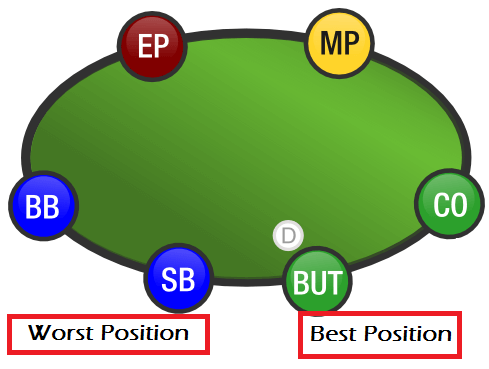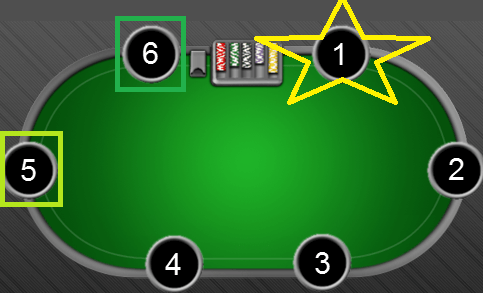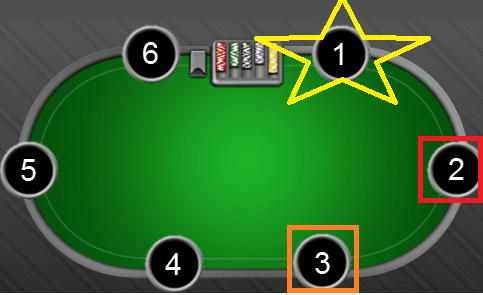One of the first concepts successful poker players must understand is position. Playing Poker in Position is often the difference between winning or losing with the exact same hand.
If you are a beginning poker player, you’ve probably heard terms like “In Position”, “Out of Position” but don’t quite understand what they mean or why they are important. This guide will sort you out
Defining Position in Poker
Memorize this: the Dealer is the best seat on the table and the Small Blind is the worst.
Why? The Dealer will always act last on the Flop, Turn and River. He/she has position on every other player.
Similarly, the small blind will always be out of position postflop and act last.
Moving clockwise from the small blind, the big blind is one step better, then EP, then MP, then CO and finally BU. Positions are good or bad depending on how many other players they have position on.
I’ve summarized this idea in a table below:
| Position | In position against (acts after) | Out of position against (acts before) |
| Dealer or Button (BU) | All players | No players |
| Cutoff (CO) | MP, EP, BB, SB (4/5 players) | BU |
| Middle position (MP) | EP, BB, SB (3/5 players) | BU, CO |
| Early Position (EP) or Under the Gun (UTG) | BB, SB | BU, CO, EP (3/5 players) |
| Big Blind (BB) | SB | BU, CO, EP, BB (4/5 players) |
| Small Blind (SB) | No players | All players |
The Importance of Position of Poker
Position is a massive advantage in Poker. You get to see what your opponent does before you act, which allows you to use more information than your opponent.
But it’s not just that – position gives you other strategic advantages as well.
Position gives you the final say on each street. It allows you to close the action with a check if you want no more money to go in on that street. It also allows you to make sure, whether or not you have the initiative, that a bet goes in on a street if you want it to.
So, players with position:
- See their opponents’ moves before deciding on their own
- Take free cards more easily when drawing
- Pot control better with showdown hands
- Can raise Cbets without having to check first and risk missing a street of value
- Can float Cbets and wait to see what the opponent does on the turn before stabbing, calling, or folding
These advantages allow a player to play a wider range profitably in position.
How your Seat determines Position in Poker
Imagine you are Player 1 in the image above. You are said to be In Position against 6 and 5. Player 6 will only have position on you when he holds the button, while player 5 will have position on you when he holds the button or the cutoff. That means 5/6 times you will have position on 6, and 4/6 hands you will have position on 5.
In the same way, 2 will have position on you except when you are on the button, and 3 will have position on you as long as you don’t hold the button or cutoff. You are Out of Position against Players 2 and 3.
Conclusion
Position in poker is a function of your seat on the table, and where the button is on any particular hands. The better your position, the wider range you can play profitably due to the wide strategic advantage given by position in poker.
























